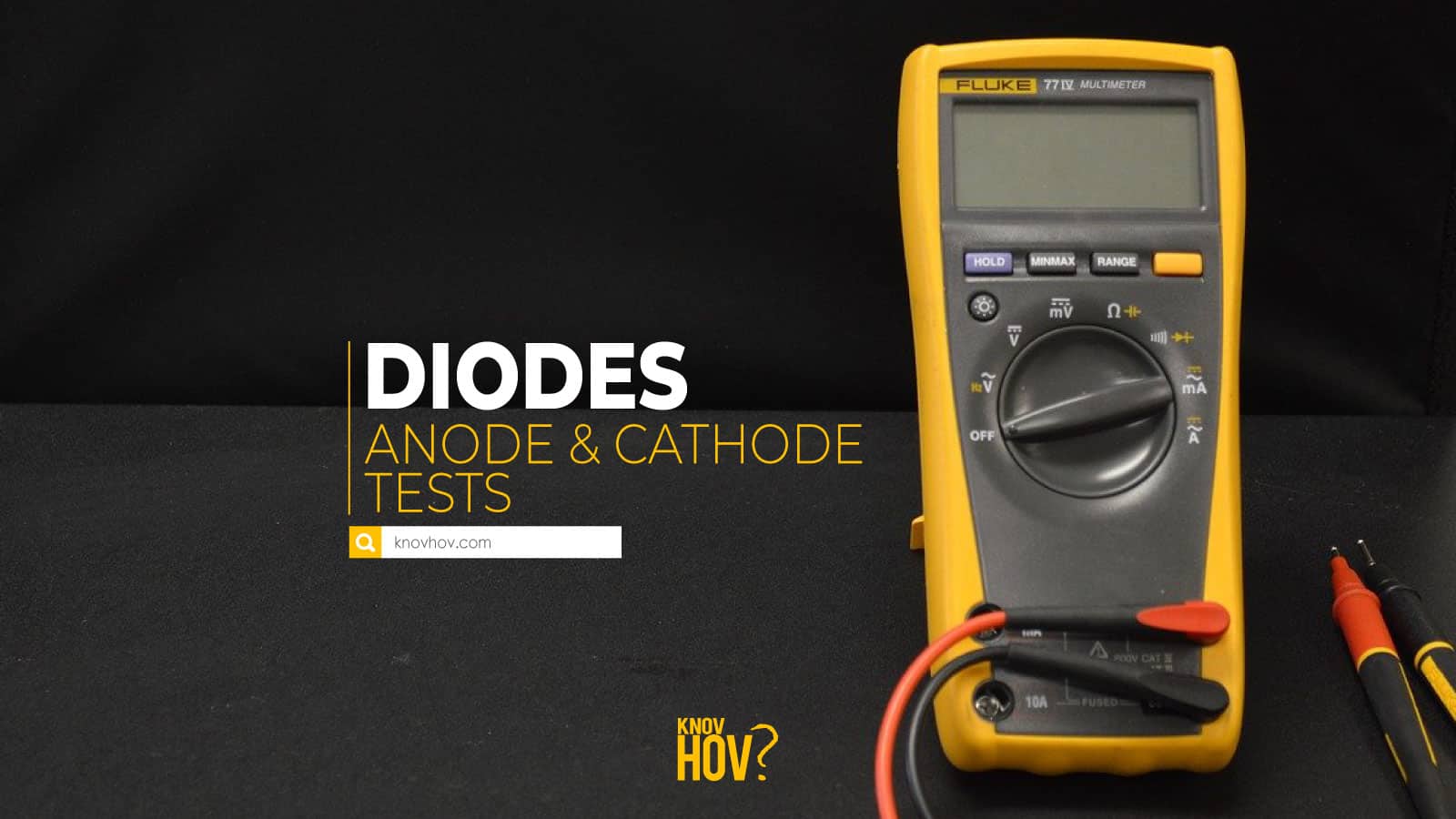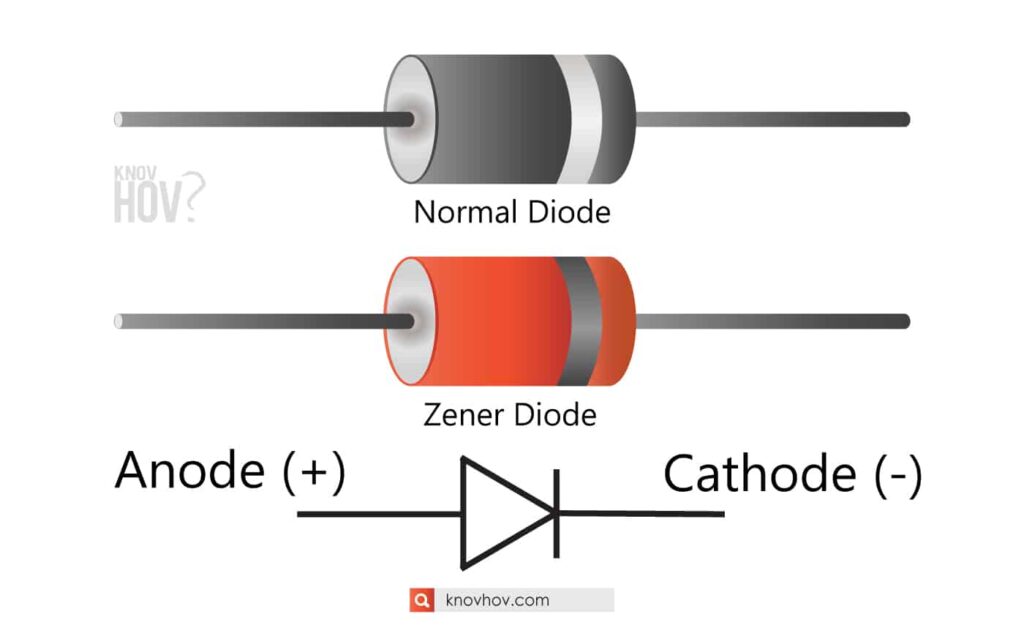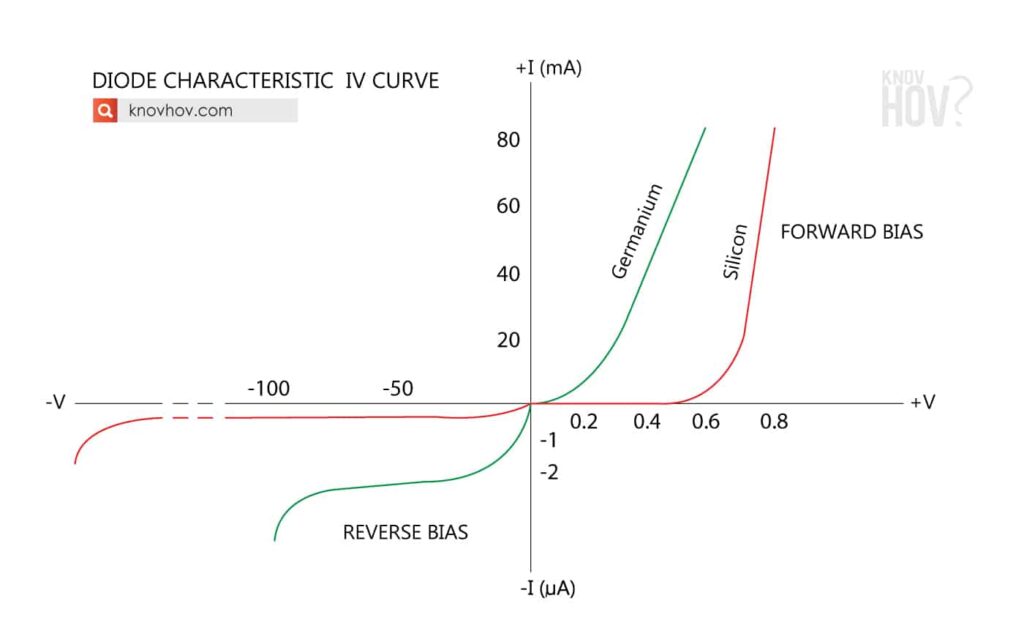How to Find Anode Cathode of Diode: 3 Testing Methods in Step-by-step

DIODE DEFINITION
A diode is an electronic component with two terminals that conducts current mainly in one direction.
Diode Structure and Overview
Diodes have a high resistance in one direction (reverse biased) and nearly zero resistance in the other direction (forward-biased).
Semiconductor diodes are widely using in the present and the two terminals are connected with a p-n junction. Mainly diodes are made of the semiconductors ( having properties between a conductor and an insulator ).
semiconductor materials which are in group 4 with 4 valence electrons like Silicon and Germanium are widely in use (except carbon).
Diode symbol and polarity
How to find anode cathode of diode?
Anode Cathode of Diode can be easily identified by its physical appearance. Near the Cathode ( negative ) terminal, there’s a silver or black ring around the diode. So the terminal having that silver or black colour strip is the cathode and the other terminal is the anode ( positive )
Diode polarity can also be identified by its symbol. A diode has two terminals, the positive and the negative. In the symbol, It’s an arrow symbol that points from the positive (anode) side to the negative ( cathode) side.

Diode characteristic IV curve
As diode is a nonlinear device it has a non-linear characteristic curve. The graph of current vs. voltage is a curve and not a straight line. The diode voltage must exceed the barrier voltage to conduct the current and that barrier potential produces a knee in the curve that is known as the knee voltage of the curve. The knee voltage (cut-in voltage) is about 0.7 volts for silicon diodes and about 0.3 V for germanium diodes.

Diode types
- Zener diode
- PN junction diode
- Light-emitting diode
- Backward diode
- Schottky diode
- Point contact diode
- Varactor diode
- Laser diode
- Photodiode
- Tunnel diode
What is a ZENER DIODE?
Zener diode is a special silicon semiconductor diode that can conduct current reverse direction when it reaches a specific voltage (Zener voltage)
Diode tests
How to test a diode using a digital multimeter
Digital multimeter is the most suitable equipment in case of how to find Anode and Cathode in Diode. There are two tests that can be implemented.
- Finding the anode cathode of diode using the Diode mode testing
- Finding the anode cathode of diode using Ohmmeter ( resistance ) mode testing
How to Find Anode and Cathode in Diode using the Diode mode testing in digital multimeter
- Rotate the central knob to where the diode symbol is indicated which is the diode checking mode in the digital multimeter.
- Keep the red phobe (+) and the black phobe (-) in either terminal of the diode.
- Check the readings on the display.
- If there’s a voltage value is displayed, then the diode is forward biased and the terminal where u kept the red phobe is the anode and the terminal where u kept the black phobe is the cathode of the diode. ( If the displayed voltage is about 0.6 – 0.7, then it’s a silicon diode which is forward biased and that value is 0.25 – 0.3 for Germanium diodes )
- If the display didn’t show any value or it displays “OL”, that means there’s no current flowing through the diode and it’s in the reverse biased condition where the red phobe is on the cathode.
How to Find Anode Cathode of Diode using Ohmmeter ( resistance ) mode testing in the digital multimeter.
- Set the central knob to the resistance testing mode where the Ohm symbol is indicated.
- Keep the red phobe and the black phobe on either side of the diode.
- Check the readings on the display by rotating the central knob from low resistance modes to high resistance modes.
- If the display gets a low resistance value in a low resistance checking mode, then it’s forward biased and the red phobe is on the anode and the black phobe is on the cathode.
- If the display gets a very high resistance value or ” OL ” that means the diode is reverse biased where red phobe is on the cathode and the black phobe is on the anode. Diodes induce very high resistance when they are reverse biased.
How to Find Anode and Cathode in Diode using Analog Multimeter
- Connect the positive phobe to the positive terminal of the diode (anode) and the negative phobe to the negative terminal of the diode ( cathode )
- Then the reading should give a low resistance value hence it is forward biased.
- Then connect positive phobe to the cathode and negative phobe to the anode.
- Then the reading should display a high resistance value ( OL condition ) hence the diode induces a very high resistance when it is reverse biased.
FAQ :
Why is the forward resistance of the diodes not same when measured in different scales of the digital multimeter?
A diode is a non-linear electronic device. changes in the scale of the digital multimeter will result in a change of current and the resulting forward resistance. Therefore it gives different resistance values with different scales.
What is knee voltage of a diode?
The diode voltage must exceed the barrier voltage to conduct the current and that barrier potential produces a knee in the curve that is known as the knee voltage of the curve. The knee voltage (cut-in voltage) is about 0.7 volts for silicon diodes and about 0.3 V for germanium diodes
How to set Resistance Mode in digital multimeter?
Turn the central knob to the resistance testing mode where the “Ω” Ohm symbol is indicated. Digital multimeters set to the “resistance” mode indicate non-continuity by displaying “OL” (Open-Loop) or dashed lines on the display.
DO YOU KNOW HOW to identify the 3 pins of Transistor correctly ?
